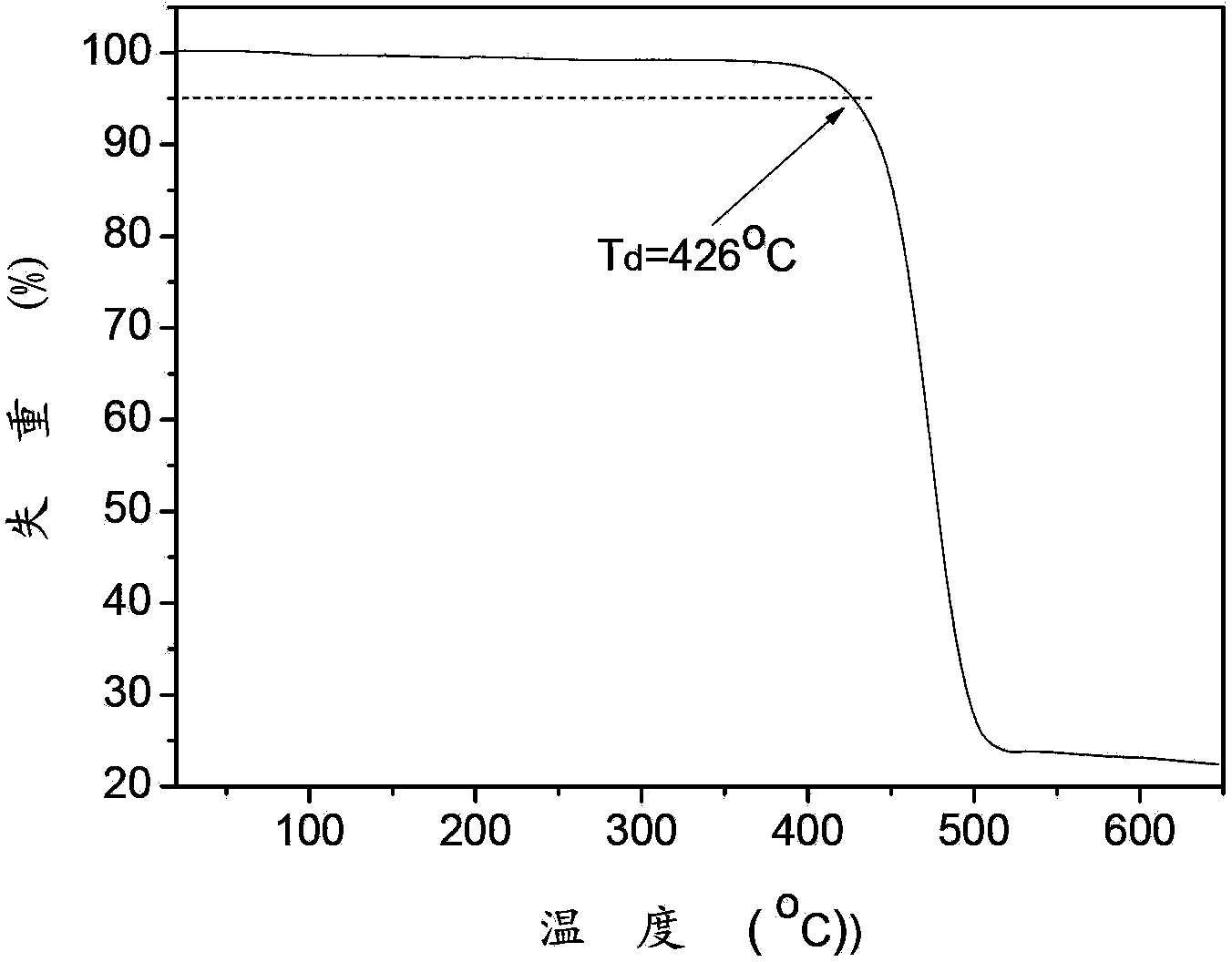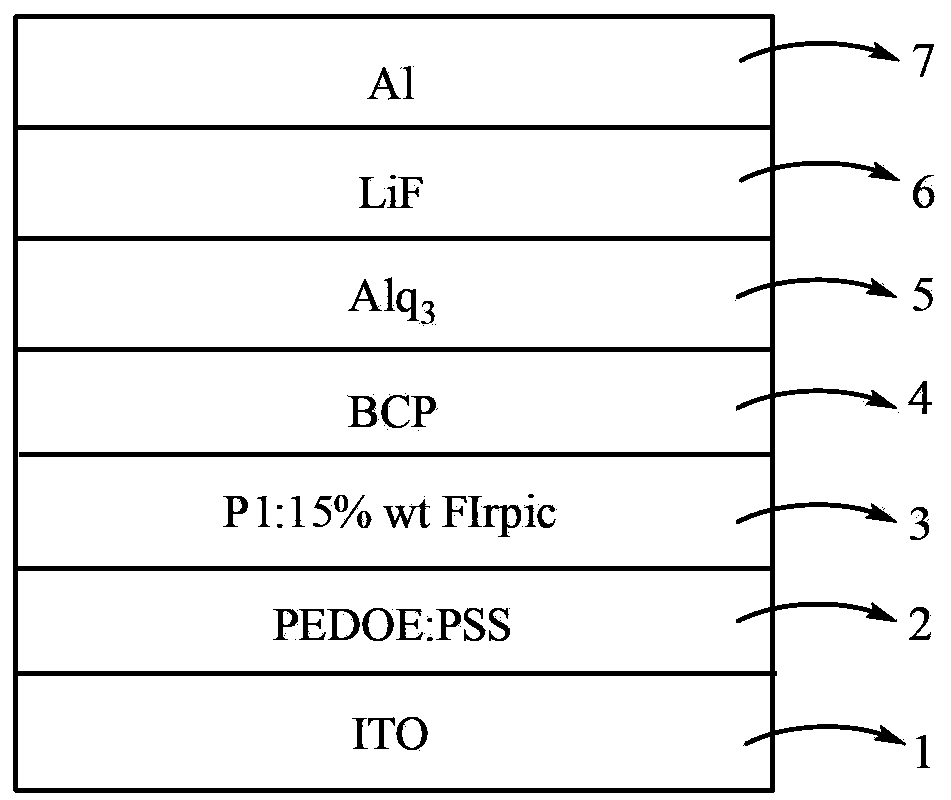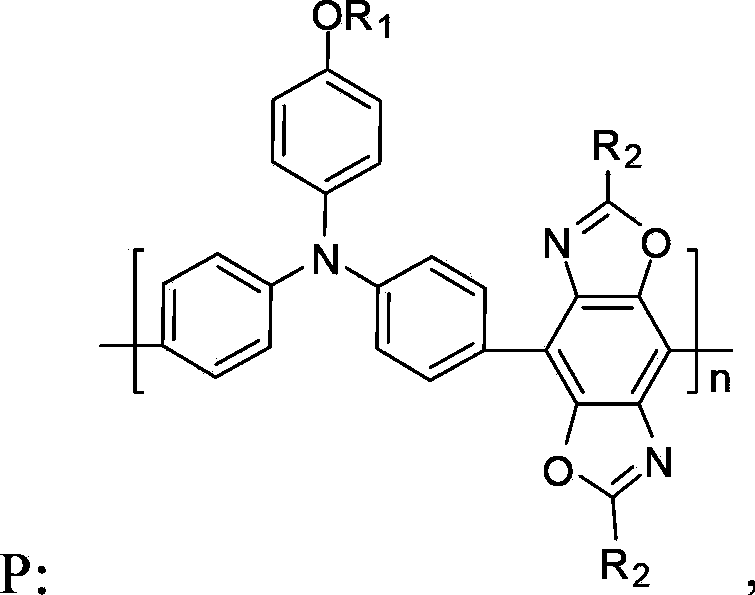Bipolar copolymer blue-light main material, preparation method thereof and organic electroluminescent device
A blue light host material, bipolar copolymer technology, applied in the direction of electric solid device, semiconductor device, semiconductor/solid state device manufacturing, etc., can solve the problems of complex synthesis, harsh preparation conditions, etc., achieve simple preparation method, thermal stability, etc. Good, mild conditions
- Summary
- Abstract
- Description
- Claims
- Application Information
AI Technical Summary
Problems solved by technology
Method used
Image
Examples
Embodiment 1
[0039] A bipolar copolymer blue light host material, namely poly{4'-n-hexyloxy-N,N-bis(4-ylphenyl)aniline-co-2,6-di-n-hexyl-4,8- Diylbenzo[1,2-d;4,5-d']bisoxazole} (n=60), denoted as copolymer P1, the structural formula is as follows:
[0040]
[0041] The preparation method comprises the following steps:
[0042] Compound A1 and Compound B1 are provided respectively:
[0043]
[0044] Under argon protection, 4'-n-hexyloxy-N,N-bis(4-pinacol borate phenyl)aniline (122mg, 0.2mmol), 2,6-di-n-hexyl-4, 8-Dibromobenzo[1,2-d;4,5-d']bisoxazole (97mg, 0.2mmol) was added into a flask containing 10ml of toluene solvent, and potassium carbonate (2mL, 2mol / L) The solution was added to the flask, vacuumed to remove oxygen and filled with argon, then bistriphenylphosphine palladium dichloride (5.6mg, 0.008mmol) was added, and the flask was heated to 100°C for the following Suzuki coupling reaction for 48h:
[0045]
[0046] Subsequently, the polymerization reaction was stopped aft...
Embodiment 2
[0050] A bipolar copolymer blue light host material, namely poly{4'-methoxy-N,N-di(4-ylphenyl)aniline-co-2,6-di-n-eicosyl-4, 8-diylbenzo[1,2-d;4,5-d']bisoxazole} (n=100), denoted as copolymer P2, the structural formula is as follows:
[0051]
[0052] The preparation method comprises the following steps:
[0053] Compound A2 and Compound B2 are provided respectively:
[0054]
[0055] Under the protection of a mixed gas of nitrogen and argon, 4'-methoxy-N,N-bis(4-pinacol borate phenyl)aniline (158mg, 0.3mmol), 2,6-dinormal di Add dedecyl-4,8-dibromobenzo[1,2-d;4,5-d']bisoxazole (263mg, 0.3mmol) and 15mL tetrahydrofuran into a 50mL two-necked bottle, fully dissolve and pass After entering the mixed gas of nitrogen and argon and exhausting the air for about 20 minutes, tetrakistriphenylphosphine palladium (4mg, 0.003mmol) was added into it, and after fully dissolving, sodium bicarbonate (3mL, 2mol / L) solution was added, and then fully After purging the mixed gas of nitr...
Embodiment 3
[0060] A bipolar copolymer blue light host material, namely poly{4'-n-eicosyloxy-N,N-bis(4-ylphenyl)aniline-co-2,6-dimethyl-4, 8-diylbenzo[1,2-d;4,5-d']bisoxazole} (n=91), denoted as copolymer P3, the structural formula is as follows:
[0061]
[0062] The preparation method comprises the following steps:
[0063] Compound A3 and Compound B3 are provided respectively:
[0064]
[0065] Under nitrogen protection, 4'-n-eicosyloxy-N,N-bis(4-pinacol borate phenyl)aniline (238mg, 0.3mmol), 2,6-dimethyl-4 ,8-Dibromobenzo[1,2-d;4,5-d']bisoxazole (114mg, 0.33mmol), palladium acetate (3.5mg, 0.015mmol) and tris(o-methoxyphenyl) Phosphine (21mg, 0.06mmol) was added into a flask containing 12mL of N,N-dimethylformamide, and after fully dissolving, potassium carbonate (3mL, 2mol / L) solution was added, and then nitrogen was vented into the flask to exhaust the air for about After 30 min, the flask was heated to 130 °C for 12 h in the following Suzuki coupling reaction:
[0066] ...
PUM
| Property | Measurement | Unit |
|---|---|---|
| number average molecular weight | aaaaa | aaaaa |
| number average molecular weight | aaaaa | aaaaa |
| number average molecular weight | aaaaa | aaaaa |
Abstract
Description
Claims
Application Information
 Login to View More
Login to View More - R&D
- Intellectual Property
- Life Sciences
- Materials
- Tech Scout
- Unparalleled Data Quality
- Higher Quality Content
- 60% Fewer Hallucinations
Browse by: Latest US Patents, China's latest patents, Technical Efficacy Thesaurus, Application Domain, Technology Topic, Popular Technical Reports.
© 2025 PatSnap. All rights reserved.Legal|Privacy policy|Modern Slavery Act Transparency Statement|Sitemap|About US| Contact US: help@patsnap.com



